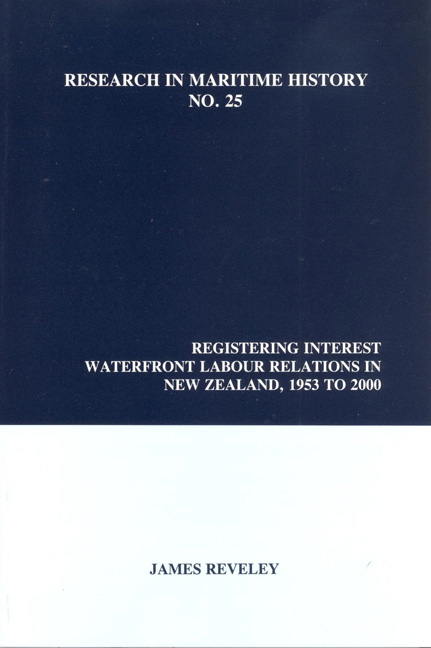Book contents
- Frontmatter
- Contents
- About the Author
- List of Figures
- List of Tables
- Acknowledgments
- Introduction
- Chapter 1 Unions and the Bureau System
- Chapter 2 The Waterfront Employers: Companies and Coordination Mechanisms
- Chapter 3 Labour Relations in the Conventional Cargo Era
- Chapter 4 Negotiating Technological Change
- Chapter 5 Labour Relations after Containerisation
- Chapter 6 Waterfront Labour Reform
- Conclusion
Chapter 3 - Labour Relations in the Conventional Cargo Era
- Frontmatter
- Contents
- About the Author
- List of Figures
- List of Tables
- Acknowledgments
- Introduction
- Chapter 1 Unions and the Bureau System
- Chapter 2 The Waterfront Employers: Companies and Coordination Mechanisms
- Chapter 3 Labour Relations in the Conventional Cargo Era
- Chapter 4 Negotiating Technological Change
- Chapter 5 Labour Relations after Containerisation
- Chapter 6 Waterfront Labour Reform
- Conclusion
Summary
In September 1961 the Union Steam Ship Company sent one of its Australian wharf superintendents across the Tasman Sea to look at the company's stevedoring operation in New Zealand. Captain J. W. Thomson was aghast at what he saw on the wharves: “I viewed with amazement the colossal wastage of waterside labour at both Wellington and Auckland.” He claimed to have watched wharfies allocated to Union vessels standing idly on the wharf because “there was not the work there for them” and noted the tendency for “morning and afternoon tea breaks at Wellington…[to] run into half an hour or more.” At Auckland he drew the conclusion that “slow turn round and labour shortages suffered were accentuated considerably by rather fantastic and unrealistic agreements with the waterside workers.”
Captain Thomson was reporting to his managers just ten short years after the 1951 waterfront dispute. This account of his experiences as an observer of waterfront work conveys the point that the crushing of the WWU in 1951 failed noticeably to increase waterfront employer prerogative. This chapter explores the different dimensions of that failure and locates the reasons for it squarely within the institutional arrangements of the bureau system. On the one hand, the bureau system continued to exacerbate the inherent problems of control associated with the performance of work by gangs, just as it had done prior to 1951. On the other, waterfront unionism thrived in the institutional environment provided by the bureau system. Mounting union strength was expressed through a blend of national, local and workplace bargaining, bolstered by the strategic threat and use of strike action in defiance of legal restrictions on the right to strike.
Bargaining Structures
Many of the so-called “fantastic” agreements, that served to sustain the practices Captain Thomson observed were formal agreements concerning gang sizes, hours of work and base rates of pay. The process by which formal agreements were reached between the wharfies’ unions and the waterfront employers in the post- 1951 period differed from the pattern of bargaining in most industries in New Zealand.
- Type
- Chapter
- Information
- Registering InterestWaterfront Labour Relations In New Zealand, 1953 To 2000, pp. 55 - 84Publisher: Liverpool University PressPrint publication year: 2003



